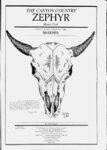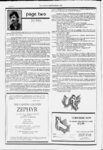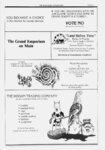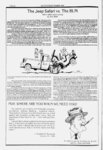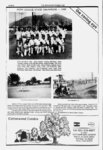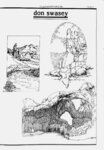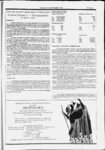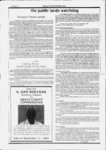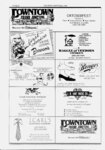| OCR Text |
Show THE ZEPHYRSEPTEMBER 1990 PAGE 18 Happy Birthday Grand County A Reflection by B.J. Eardley researching the late 1800's In southeastern Utah, I stumbled across the fact that the area encompassed by Grand County had been part of the original proposal for San Juan County. The boundary was rejected because, In the words of then Utah Governor George Emery: "It contained too much territory for the convenience of the people. That While was 1880. discovered that San Juan received Its county status that year, establishing Bluff as the county seat I also learned that Grand County would not be separated from Emery County for another 10 years. That was 1890. It was, In fact one hundred years ago, In march of 1890, that the Utah Territorial Legislature created Grand County and designated Moab as Its county seat I was Intrigued. My historian self Is happily entertained with reflections on the past when they fall Into neat packages of 25 years ago, 50 years ago, etc. I was delighted with the fact that It was Grand Countys centennlaf year. I felt that someone should at least say Happy Birthday to dear old Grand. What better was to celebrate than to reflect on our I Providing education for the children In Grand County was a struggle which prompted letters to the Territorial Legislature requesting a change In the criteria used to provide financial support for county schools. The request asked for a reduction In required average attendance from 12 students to 7, which was felt necessary to establish schools In sparsely settled areas. Grand County officials charged that the Territorial Government's system of tax distribution was discriminatory against rural areas. There were two schools In Moab In 1890. The upper school still stands near the comer of 5th west and 4th north. Uke many of the buildings In the Moab area that are over 100 years old Is disguised by years of remodels and conversions and now serves as a duplex. The lower school which was located on the site of the current Middle School was built on property donated by "Doc Few clothes, Texan cowboy Tom Trout Trout won the property In a horse race, then lost his heart to a local Moab lady and eventually saw grandchildren benefit from his lucky bet early beginnings. And so It began. I reviewed published works, Journals, and oral histories. I talked to children of Moab Valley's original pioneers. I shuffled carefully through solidly bound pages In record books that perch high above the clerk's head on the upper shelves of the county record vaults. Gradually I found bits and pieces that related to life In Grand County In 1890. reaffirmed what I already knew about the lifestyle of Grand County's early residents was a contrast to today's contemporary conveniences. The first deed books reflected the transfer to public lands from federal control to the hands of farmers and ranchers who had come to southeastern Utah to claim a part of the new frontier. To do so they had cleared land of rocks, sagebrush and greasewood, channeled the waters of creeks and springs, and built homes of logs and mud. From the keepsakes of such hardworking pioneers I found a young girls delicate red velvet autograph book and read the fountain pen script that had been placed there one hundred years before. "When you marry, marry well, said the neatly penned words, "for what time will bring you cannot tell...For thee, my fair and gentle friend, I ask not wealth and fame. I only ask thy path may be free from lifes care and pain. I had visions of hauling water long distances In a wagon, of baking bread on a wood stove on a scorching summer day, of homespun cloth being worn by a houseful of children. I saw a life without many options and more work than there were hours In a day. Grand County's seat of government was little more than a frontier outpost In 1890. The nearest bank was In Grand Jet There was no doctor, no hospital, and no newspaper. Moab boasted a freight company, one general store, two hotels and two schools, serving approximately 80 children. It was a community that contrasted sharply with todays bustle of commercial development As 1 looked closer, however, I saw a young county struggling to meet the needs of Its growing communities. It established voting precincts and legal authority. It looked for means to support schools, to provide for road construction, maintenance and repair. I realized that the contrasting world of 1890 was also an anticipation of the coming century. One of the first acts of the new government was to levy a tax of 2 mils on the dollar to support schools. Fees were also established for merchants, peddlers and liquor licenses. An assessment of an additional 3 mils on the dollar provided for general county purposes. Then, as now, citizens contested their property taxes or fell Into 'default over them. I traced the countys attempts to establish a wagon road from the Moab Ferry to the train station at Cisco. I scanned the testimony of farmers as the Moab Irrigation Company adjudicated water rights to Mill and Pack Creeks. I followed the course of the construction of county facilities, the creation of new positions and the failures and successes of bond Issues. When I looked through the faded century old photographs, I saw another aspect of Grand County. I saw the faces of people who had found a home In the land of redrock canyons, deep-wall- ed rivers, frozen mountain meadows, and expansive pygmy forests. Not all of them liked the ruggedness of the land or could tolerate what It took to survive here. But In some of the faces I could see It They were home and they never wanted to leave. Some never did. Their children and their childrens children have mixed with the blend of community which has weathered the boom and bust that began as Grand County one hundred years ago. At first I Here Is a sampling of Grand County's first years: Grand County's population spread among the towns of Dewey, Richardson, 'Cisco, Thompson's, settlement of Picture the Dolores Castleton, and the In 1890 tiny Gallery In Triangle. Other towns would Join the list: Sego, Valley City, Miner's Basin, Elgin, Westwater.. Jmt most would turn to the shells of ghost towns. None would survive with the same energy that keeps Moab at the seat of county government Moabs 1890 designation as county seat prompted a group of colorful Moab citizens to petition the new court to change the name of Moab to one more befitting of Its political stature. The petition read: "We the undersigned legal voters of Grand County, Utah, respectfully represent that the name of "Moab", County seat of Grand County, being so unfavorably commemorative of the character of Incestuous and Idolatrous community existing 1897 years before the Christian era, we...therefore respectfully petition and ask your Honorable Body to change the name of said County Seat to one more appropriate, significant, or expressive of moral decency and manly dignity and In harmony with the progressive civilization of the present age. We respectfully suggest the name of: "VINA." The request was apparently never officially acknowledged due to a lack of sufficient signatures. was around 1890 that the Pittsburgh Cattle Company, the Pennsylvanian concern based In the area of LaSal and Coyote, chose to go out of business due to low market cattle companies to release Its holdings In prices. It was the first of the large Southeastern Utah. Neighboring Montlcello, barely gained Its first post office and celebrated Its first birth Anna Jones, bom In April. Montlcello's vulnerable location In the Carlisle Ranch was exemplified In 1890 midst of the powerful range of the Brttlsh-own- ed on a went riders drunken when range shooting spree down Main Street, demolishing Mons Peterson's general store and terrifying two young girls by shooting at their feet while screamlna "Nits breedjlce, It out-of-st- ate three-years-o- ld, Ai emfy M OAtf sctAft - ebovi mo. On November 12, 1890, Frank Shafer from Qulrcus Grove, Indiana and Daisy Westwood from Falrvlew, Utah became the first couple to be married In Grand County. Frank, then 22, went on to become Moab's postmaster and to serve as county clerk. He Is remembered as one of the areas first actors and as an Inventor who patented a method of making cement grave markers. Most of the pioneers who entered the Moab Valley passed through the precarious cliffs of the "Jumping off place In Moab Canyon near the entrance to what Is now Arches National Park. Frank, on the other hand, entered the county by raft from Cisco with 500 pounds of supplies. He established a place In Castle Valley, but sold out a year later to Sid Pace and moved to Moab where he met and married, Daisy, age 19. In August of 1890, Dick Westwood, a relative of Daisy, found himself elected as Sheriff after being In Grand County for a short 6 months. He served for two years before he was forced to quit because the small salary was not enough to support his family. Ironically, Dick Westwood was killed In 1929 In a Jail break while he was serving as deputy sheriff. LDS Church President Wllford Woodruff denounced the practice of plural marriage as part of the official doctrine of the Mormon church. It was a move that worked towards helping Utah achieve statehood In 1896. The decision forced hundreds of practicing polygamists to abandon their families to serve Jail sentences. Affected Moab polygamists included fruit farmer, R.H. Stewart, the bishop of the Moab Ward, and the producer of the award-winni"Stewart Peach; and Norman Taylor, who established the first ferry across the Colorado River and built the first grist mill In Moab. Local farmer O.W. Warner wrote to the Deseret News proclaiming that thousands of dollars of peaches could be produced In the Moab Valley each year. Warner, along with other early Moab homesteaders had encouraged the planting and production of fruit orchards. Along with the Lances, Millers, and Stewarts, Warner would establish the beginnings of a fruit Industry that would lead Grand County to the status of Utah's fruit ng BBBBBBB9BBBBBBBBBBOBBBBBBBBB9EBESBSBSSSBBS9BBS WHY BIERSCHIED FOR GRAND COUNTY COMMISSION? Do you want planned development? His background is in planning. Do you want representation for all the people? He believes in serving all of Grand Countys residents, indluding those within the cities. Do you feel that directing Grand Countys future is more important than dwelling on its past? THEN REMEMBER... BIERSCHIED IN NOVEMBER paid for by Committee to Elect Bierschied |
